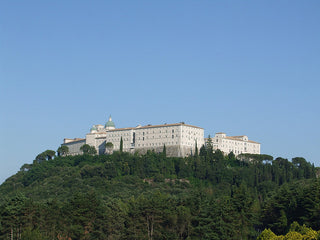Benedict of Nursia was born in 480 into a righteous Italian family, which sent him to a Roman school as a youth. Back then, the western Roman empire was collapsing, and the customs and moeurs of that period struck the young Benedict to such an extent that he fled the city soon after.
After leaving a fallen Rome, young Benedict retired to Subiaco, a small town halfway between Rome and Naples. There he spent three years as a hermit, aided in his daily necessities by a monk of a neighboring monastery. Soon enough, people of faith learned about his zealous lifestyle and started to assemble in front of his cave. The interest and consensus that he inspired resulted in a considerable amount of hostility from other community leaders, who ultimately attempted to poison him, twice.

The first Benedictine abbey, situated at Montecassino.
Benedictine Rule: Ora et Labora
Benedict teaches us that God is always with us. No matter how many times we fall along the way. With his way of living and his preaching, he established a new tradition of monasticism in the Western church.
From the Rule of St Benedict emerges the very essence of his modus vivendi, his character, and his idea of what a good Christian life should be. Although his own religious experience begun in a solitary fashion, he then redirected it to a monastic life conceived as part of a community, consecrated to the common good.
His rule is a set of guidelines aimed at organizing the daily life of a monastery, on both mundane and spiritual level. An equilibrium of relationships defines the Benedictine community, where monks elect and advise their abbot, who is, in turn, accountable before God for his actions and those of his monks.
Besides poverty, chastity, and obedience, it is fair enough to say that moderation characterizes the rule. Certain concessions counterbalance the austerity of Benedictine lifestyle: e.g., the monks are allowed to have a sufficient amount of hours of sleep, an adequate amount of food, and clothes appropriate to the weather.

Pope Honorius III, born Cencio Savelli
Random Facts about St Benedict
Since Benedictine Rule had an incredibly prominent role in the evangelization of many European countries, Pope Paul VI included Benedict of Nursia among the patron saints of Europe.
Benedict of Nursia was canonized in 1220 by Pope Honorius III from the Savelli family!
Every time a new Pope gets elected, he chooses the name under which to ascend to the Throne of Saint Peter. That name offers us an indication of what his priorities will be during his pontificate. In the history of the Catholic Church, sixteen Pontiffs selected «Benedict» as their papal name, the last one being Benedict XVI, Pope Francis’ predecessor.
St Benedict Church and Feast
Originally, Benedict’s feast day was March 21, the day of his death, and is still kept like that by Benedictine monks. However, the Roman Catholic church postponed the celebration to July 11.
If you want to come in contact with the roots of the Benedictine Order, visit the principal shrine of the saint at the Monte Cassino Abbey.
Benedict of Nursia is hugely popular among worldwide believers for two powerful pieces of religious jewelry bearing his name and resuming the famous St Benedict exorcism prayer: St. Benedict medal and St. Benedict cross. You can get familiar with its symbology at our dedicated blog post below.
Related Articles:


